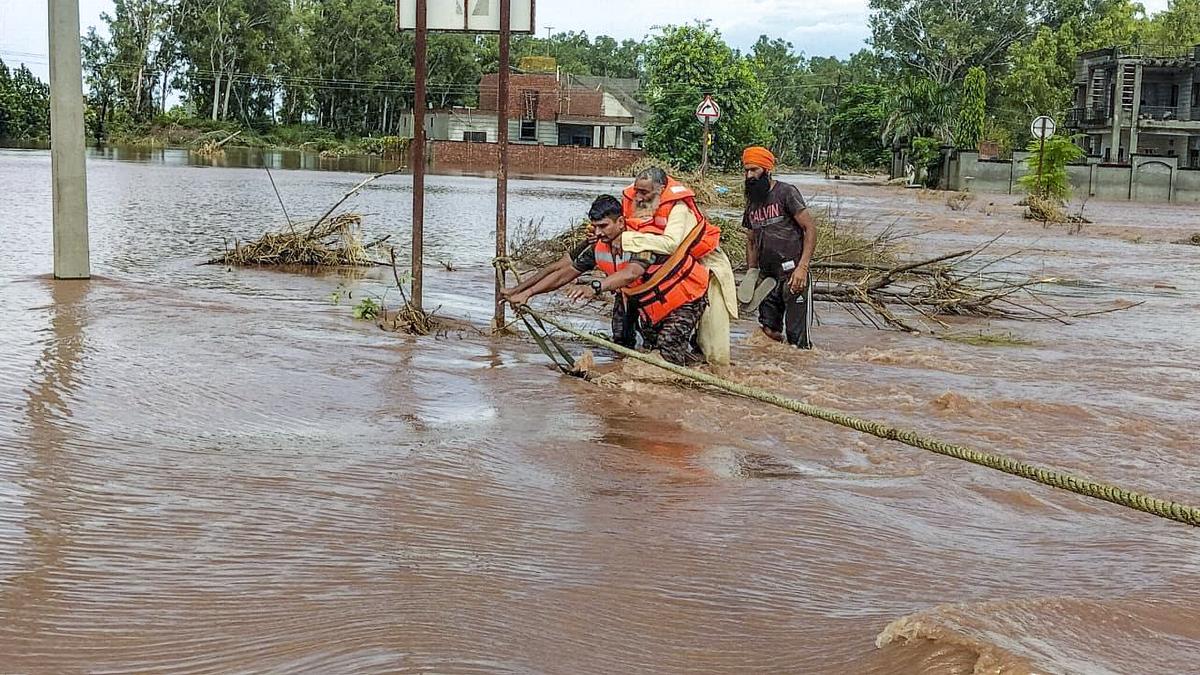Now Reading: Yamuna Floods Inundate Delhi Homes, Punjab Sees Rain Relief
-
01
Yamuna Floods Inundate Delhi Homes, Punjab Sees Rain Relief
Yamuna Floods Inundate Delhi Homes, Punjab Sees Rain Relief

swift Summary:
- Delhi: Rising Yamuna water level submerged homes, disrupted traffic; diversions implemented by Delhi Traffic Police. In Kalindi Kunj, 1,180 people rescued by NDRF after floods.
- Punjab: Severe floods reported; CM Mann ill, Cabinet meeting postponed.Floods impacted agriculture on over 1.71 lakh hectares; death toll stands at 43 as of Thursday.
- Jammu and Kashmir: Around 283 houses damaged in Ramban district after cloudbursts and flash floods forced evacuation of 950 people. Jammu-Srinagar highway remains closed due to landslides for the fourth day; Mughal road reopens in parts.
- Himachal Pradesh: Monsoon-led devastation resulted in a death toll of 355 since June with major casualties from landslides and heavy rains across all districts including Mandi, Kangra, Shimla & Kullu regions suffering maximum losses.
- Maharashtra Agricultural Impact: Heavy rainfall destroyed crops on nearly 14 lakh hectares across key Kharif plantations soybean, cotton-turmeric etc saw losses this year.
Indian Opinion Analysis:**
the wide-scale destruction caused by unrelenting monsoons underscores the urgency required for enhanced disaster preparedness at state regional implementation failure worsens damages specific connectivity bridging road(s) zones highlight prioritiesQuick Summary:
- Rajasthan: deputy CM Prem Chand bairwa confirmed Ministers’ visits to assess rainfall damage following heavy downpours in the state.
- Delhi: Yamuna River overflowed, submerging Kalindi kunj; NDRF deployed for rescue operations.
- Punjab: Severe floods displaced thousands as waters recede slowly; ludhiana is on high alert due to embankment strain.
- gujarat: Surat, Vadodara, and Bharuch face flood alerts due to torrential rains and rising rivers.
- Odisha: CM’s flight diverted from Bhubaneswar to Kolkata owing to bad weather conditions.
- Telangana (Kamareddy): Record rains caused catastrophic flooding-homes submerged, crops destroyed during Ganesh Chaturthi celebrations; district received 40.7% of annual rainfall in three days.
- Jammu & Kashmir: Pilgrimage to Mata Vaishno Devi suspended for the 11th day due to landslide aftermath; Army constructed a footbridge near Bhaderwah within 18 hours after cloudburst-related flash floods isolated villages.
- Himachal Pradesh (Manimahesh Yatra): IAF rescue operations underway for stranded pilgrims using Chinook helicopters and local transportation measures by authorities.
- Mumbai: Under cloudy skies with IMD predicting moderate rain after recording up to 15.32 mm rain across suburbs in the last 24 hours.
Indian Opinion Analysis:
India faces a coordinated crisis stemming from extreme monsoon conditions impacting multiple states-a stark reminder of nature’s fragility when balanced against development pressures. The widespread destruction-from agricultural losses in Punjab and Telangana to submerged streets in Rajasthan-calls for enhanced disaster preparedness frameworks at all levels.
The deployment of NDRF and rapid relief efforts by the Army underscore India’s growing capacity for emergency response but raise questions regarding urban planning and infrastructure resilience, especially evident from Delhi’s overwhelmed yamuna areas and Himalayan regions where unchecked development adds vulnerability.Recovery will likely hinge not onyl on immediate relief programs but also long-term policy reforms emphasizing lasting development alongside robust warning systems. These events highlight how interconnected india’s rural livelihoods, urban expansion challenges, climate patterns, and disaster mitigation are becoming-a call-to-action far beyond mere reactionary measures.
For further details: Read More
Quick Summary
- Telangana:
– Heavy rains in Telangana resulted in notable losses of crops, property, and human lives.
– Telangana Government requested ₹16,000 crore financial aid from the Union Government to manage damages.
– Rainfall this monsoon season is recorded at 25% above normal; eight districts reported excess rainfall ranging from 65%-95%.
- National Capital Region (NCR):
– Parts of NCR, especially Noida and delhi, remain flooded as the Yamuna River flows above the danger mark (205.33m).
– Evacuations underway as water levels exceeded warning marks.
– IMD forecasts partly cloudy skies with intermittent rain or thunderstorms for the coming week.
- Himachal Pradesh:
– Kullu district witnessed flooding from the Beas River as it damaged security walls protecting Tibetan Colony.
– A landslip caused two houses to collapse in Kullu leaving one dead and six buried under debris; rescue operations recovered three individuals.
– Over a thousand roads are closed across Himachal Pradesh due to extreme weather disruptions.
- Jammu & Kashmir:
– Floods affected Pulwama, Budgam, and Srinagar districts after Jhelum breached an embankment. Around 9,000 people were evacuated to safer locations.
– Union Science Minister announced installation of four additional radars under ‘Mission Mausam’ for improved weather warnings.
Indian Opinion Analysis
the ongoing heavy rains across several states underscore India’s vulnerability to extreme monsoon events exacerbated by climate change. Telangana’s appeal for ₹16,000 crore financial assistance raises critical questions about post-disaster recovery funding adequacy at both state and central levels. Proactive disaster management policies could further limit such recurrent damage in future monsoons.
The flooding impact on NCR highlights urban planning issues where rivers overflow into populated lowlands during heavy rainfall.Evacuation protocols suggest preparedness but also stress infrastructural deficits amidst unpredictable climate behavior.
In Himachal Pradesh and Jammu & Kashmir alike, mountain terrains have faced repeated challenges due to unseasonal torrential downpours-compounding risks like landslip fatalities or river breaches causing mass evacuations. Mitigation efforts such as radar installations are hopeful measures toward more accurate forecasting but require complementary investment in sustainable infrastructure planning across susceptible regions.
India seemingly faces an urgent need for cooperative governance between local authorities and national agencies alongside substantial focus on integrating climate-resilient urban development strategies nationwide.
























